JUNE 2020 UPDATE: I’ve let this feature go out-of-date, and there are dozens of new projects that have come online since I began writing about them more than a decade ago. The best way to stay current and learn about exciting new projects is on the website of the High Line Network, founded by Friends of the High Line, a group that shares resources and strategies for successfully creating new urban greenways around the country and the world.
All over the country – and indeed the world – the impact of the High Line is being felt. Every week, it seems, brings a new story of someone who’s dreaming of a park made from an old railway, and in many places those dreams are becoming reality. In Fall 2011 I made two trips to Philadelphia to walk the Reading Viaduct, a former elevated railroad that offers stunning views of the Philadelphia skyline as well as intimate glimpses of everyday life in the streets below. Just like the High Line.
Walking the elevated part of Philadelphia’s abandoned railway made me finally understand what so many early visitors to the High Line saw and fell in love with when today’s “park in the sky” was a wild urban garden. That in turn made me fascinated to learn about the many other efforts that are taking place around the country and the world. In cities across America community leaders and urban planners are looking to the High Line for inspiration, and one can sense an exciting new trend in urban reclamation like a heartbeat pulsing from one end of the country to the other. [Go here to read the full blog post.]
This special LivinTheHighLine feature, “Urban Greenways,” identifies these efforts and provides photos where available. Below is a short list of American projects that are currently in the works, organized alphabetically. As time goes by I’ll update the list, add cities and provide progress reports. And I’ll be adding international projects as well.
Atlanta, GA: The BeltLine
In Atlanta, a section of the Beltline is open and work is underway to convert most of a 22-mile ring of abandoned rail lines circling the city into a multi-use trail, park, and transit corridor that will accommodate bicycles as well as pedestrians. One of the things that sets the Beltline project apart from all the others is that it will connect as many 45 Atlanta neighborhoods and provide important transportation options in a city glutted by automobile traffic. The idea grew out of a 1999 graduate thesis by Georgia Tech architecture student Ryan Gravel. To date roughly 11 miles of the trail system are open. Read more about the project on the BeltLine’s official website.
Chicago, IL: The 606
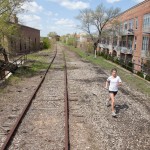 The 606 opened on June 6, 2016 and connects four ethnically and economically diverse neighborhoods on the Northwest side of the city: Logan Square, Humboldt Park, Bucktown and Wicker Park. Unlike the High Line, cyclists and dogs (!) are invited to use the 2.7 mile trail, it has 37 bridges, and eventually will connect with six street-level parks. First known as the Bloomingdale Trail, after the name of the abandoned elevated railroad that the park transforms, the name was changed to The 606 in reference to the Chicago-wide zip code prefix. In 1872, after the Great Chicago Fire, the City Council granted the Chicago & Pacific Railroad permission to build on Bloomingdale Avenue. In 1893 the council ordered all tracks to be elevated, including the Bloomingdale. Click here to read about visit and see photos of the abandoned and reclaimed viaduct.
The 606 opened on June 6, 2016 and connects four ethnically and economically diverse neighborhoods on the Northwest side of the city: Logan Square, Humboldt Park, Bucktown and Wicker Park. Unlike the High Line, cyclists and dogs (!) are invited to use the 2.7 mile trail, it has 37 bridges, and eventually will connect with six street-level parks. First known as the Bloomingdale Trail, after the name of the abandoned elevated railroad that the park transforms, the name was changed to The 606 in reference to the Chicago-wide zip code prefix. In 1872, after the Great Chicago Fire, the City Council granted the Chicago & Pacific Railroad permission to build on Bloomingdale Avenue. In 1893 the council ordered all tracks to be elevated, including the Bloomingdale. Click here to read about visit and see photos of the abandoned and reclaimed viaduct.
Detroit, MI: The Dequindre Cut Greenway
Detroit’s Dequindre Cut Greenway is a former Grand Trunk Railroad line constructed in the 1830s. The trains ran below grade from the Detroit River warehouse district — serving factories like a stove plant, a rubber company, and the Parke-Davis Laboratories — north through the Eastern Market and on to the suburbs. A 1.35 mile recreational path for joggers, cyclists, and pedestrians opened in May 2009, just weeks before the High Line. Read more and see before & after photos.
Jersey City, NJ: The Harsimus Stem Embankment
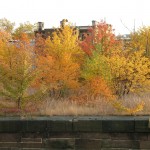 Jersey City has been considering plans to preserve the Harsimus Stem Embankment, a massive stone structure that supported seven tracks of the old Pennsylvania Railroad and connected the railroad to the Hudson River Waterfront. Of all the parks-to-railway projects in the New York area, this one offers a unique window into the fascinating “lighterage system,” which provided a means for shipping railroad boxcars across the Hudson River on “lighters” or car floats. The Harsimus Stem Embankment project is exciting for the historical context it provides and also for the ideas of sustainability and education that the Coalition has put forward as part of the design process. Click here to read more and see photos.
Jersey City has been considering plans to preserve the Harsimus Stem Embankment, a massive stone structure that supported seven tracks of the old Pennsylvania Railroad and connected the railroad to the Hudson River Waterfront. Of all the parks-to-railway projects in the New York area, this one offers a unique window into the fascinating “lighterage system,” which provided a means for shipping railroad boxcars across the Hudson River on “lighters” or car floats. The Harsimus Stem Embankment project is exciting for the historical context it provides and also for the ideas of sustainability and education that the Coalition has put forward as part of the design process. Click here to read more and see photos.
New York, NY: The Low line
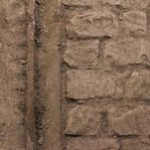 New York City already has the High Line, but another project is making headway on the Lower East Side just below Delancey Street: The Low Line. A group inspired by the “park in the sky” is fundraising and creating preliminary designs for an underground public space made from a 1.5 acre former old trolley terminal. The cornerstone of the idea is not horticulture but green technology: the plan calls for an innovative use of solar lighting to illuminate the underground space. Click here to read more, and watch a video of “this remarkable, ghostly place.” The official website for the Low Line is here.
New York City already has the High Line, but another project is making headway on the Lower East Side just below Delancey Street: The Low Line. A group inspired by the “park in the sky” is fundraising and creating preliminary designs for an underground public space made from a 1.5 acre former old trolley terminal. The cornerstone of the idea is not horticulture but green technology: the plan calls for an innovative use of solar lighting to illuminate the underground space. Click here to read more, and watch a video of “this remarkable, ghostly place.” The official website for the Low Line is here.
Philadelphia, PA: The Rail Park / The Reading Viaduct
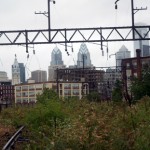 The Reading Viaduct was built in the 1890s to carry commuters to the center of Philadelphia. It’s just a mile long, and consists of two branches that connect Chinatown with the artists’ loft district. Today most of it is a wild urban garden filled grasses, perennials, and even the odd magnolia tree, but on June 14, 2018 a 1/4-mile stretch was opened to the public, and formally named the Rail Park. The official website is here. Read more about the history here.
The Reading Viaduct was built in the 1890s to carry commuters to the center of Philadelphia. It’s just a mile long, and consists of two branches that connect Chinatown with the artists’ loft district. Today most of it is a wild urban garden filled grasses, perennials, and even the odd magnolia tree, but on June 14, 2018 a 1/4-mile stretch was opened to the public, and formally named the Rail Park. The official website is here. Read more about the history here.
Shelburne Falls, MA: The Bridge of Flowers
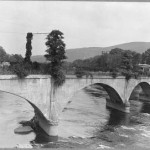 Rick Darke also turned me onto The Bridge of Flowers in Shelburne Falls, Massachusetts. “The High Line may be the most spectacular park made from an old railway,” he says, “but it is not the first. That honor belongs to the Bridge of Flowers.” Built in 1908 as a trolley bridge, it extends 400 feet on concrete arches over the Deerfield River. The railway fell victim to the rise of automobile and truck traffic and went bankrupt in 1927. The Bridge became overgrown with weeds, but in a familiar story, someone had an idea….. It took just two years for the Shelburne Falls Women’s Club to transform the abandoned bridge into a linear garden. It opened to visitors in 1929. Read more about the trolley and the Bridge and see photos here.
Rick Darke also turned me onto The Bridge of Flowers in Shelburne Falls, Massachusetts. “The High Line may be the most spectacular park made from an old railway,” he says, “but it is not the first. That honor belongs to the Bridge of Flowers.” Built in 1908 as a trolley bridge, it extends 400 feet on concrete arches over the Deerfield River. The railway fell victim to the rise of automobile and truck traffic and went bankrupt in 1927. The Bridge became overgrown with weeds, but in a familiar story, someone had an idea….. It took just two years for the Shelburne Falls Women’s Club to transform the abandoned bridge into a linear garden. It opened to visitors in 1929. Read more about the trolley and the Bridge and see photos here.
St. Louis, MO: The Iron Horse Trestle
A preservation group in St. Louis is raising funds to create a space called the Iron Horse Trestle from a 100-year old elevated rail line. The viaduct would be transformed into a pedestrian and biking trail that preserves some portion of the structure for native plantings. The structure runs through St. Louis, offering views of downtown, the Mississippi River and the adjacent neighborhoods, including Produce Row, the City’s fruit and vegetable wholesale district. Like the Reading Viaduct, this trestle also has a catenary system which provides architectural drama and historical interest.
Toronto, Canada: The West Toronto Railpath
The West Toronto Railpath is a project that’s almost as old as the High Line. In 2001 a group of residents, cyclists, politicians, activists and environmentalists got together to discuss how they could help the City of Toronto create a multi-purpose linear park that would provide a transportation link — by foot, blade, and bicycle — to downtown Toronto. In October 2009 the first section opened; it includes some landscaping and a hard-surface path extending from Cariboo Avenue to Dundas Street West. Phase two will extend the Railpath south and east towards downtown. Go here to read more.
Poughkeepsie, New York: Walkway Over the Hudson
The Walkway Over the Hudson in Poughkeepsie, New York, is the world’s longest pedestrian bridge, and is one of the oldest ideas for an urban greenway, having been conceived in 1992. It opened in 2009, just months after the High Line, and while it has no gardens or design flourishes, the history and infrastructure of this old railroad bridge are as compelling as the Hudson River views are stunning. Go here to read more.
If you’re involved with an urban greenway and would like to see it featured here, please use the contact form to email me. Thanks.

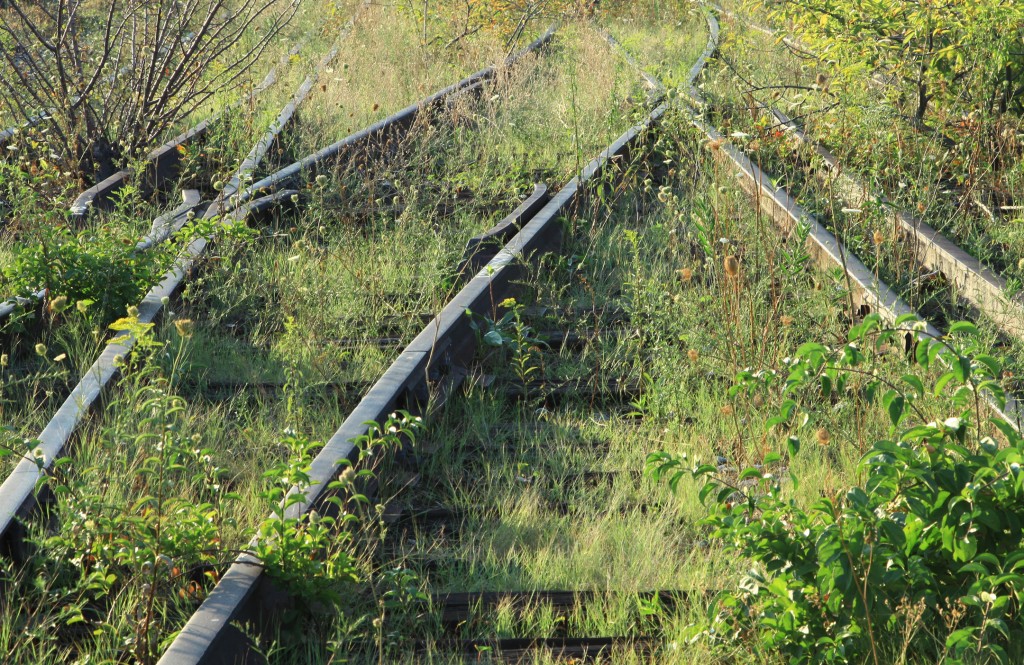
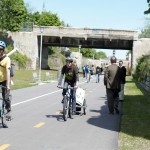
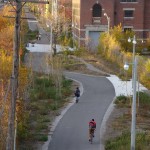
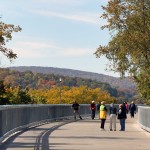

[…] is among a bevy of industrial re-imagined, reclamation successes celebrated in Annik La Farge’s latest post on her blog “Livin’ the High Line.” There, she chronicles the ongoing transformation of the […]
[…] is among a bevy of industrial re-imagined, reclamation successes celebrated in Annik La Farge’s latest post on her blog “Livin’ the High Line.” There, she chronicles the ongoing transformation of the […]
[…] are underway to create an underground equivalent to the High Line in New York City. In the early 20th century, trolleys ran underground between the […]
[…] High Line Inspired Projects [Huffington Post] Descendants of the High Line [Atlantic Cities] Urban Greenways: Other Projects Around the World [Livin The […]
[…] Annik La Farge is the author of On the High Line: Exploring America’s Most Original Urban Park (Thames & Hudson, 2012). She will be giving an illustrated talk at the American Library – with more than 100 contemporary and historic photographs – on April 2. To read more about the High Line other urban greenway projects around the world, visit Annik’s blog, LivinTheHighLine.com. […]